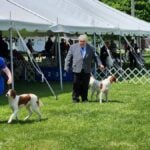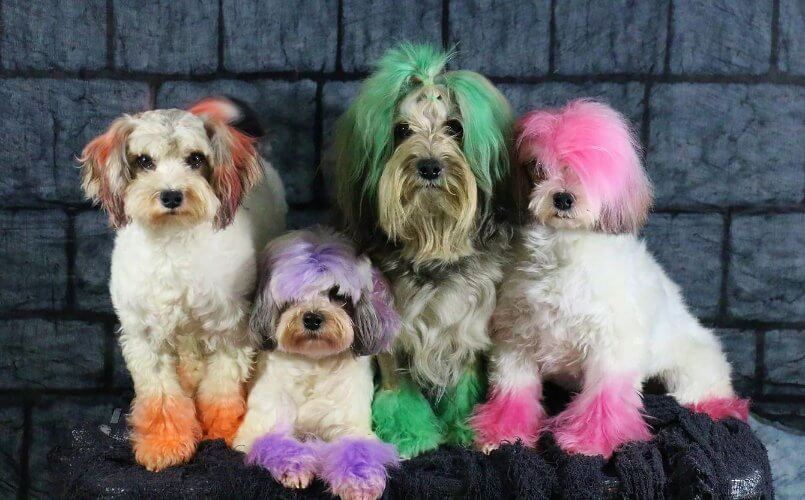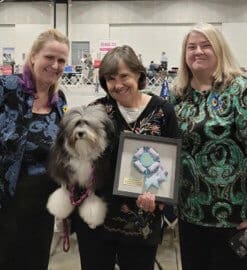
Home » Sylvan Myst Löwchen | Kat Roll & Rhonda Croxton

Interview with Non-Sporting Group Breeders Kat Roll & Rhonda Croxton
Where do we live? How many years in dogs? How many years as a breeder?
Kat Roll & Rhonda Croxton: We (Kat Roll and Rhonda Croxton of Sylvan Myst Löwchen) have been best friends since childhood and began owning and showing Löwchen in 2009. We live in rural southeastern Pennsylvania in the rolling hills of Chester County. Kat has worked with pets professionally for close to three decades—first as a vet assistant and then as a groomer, which was her calling and how she spent the next 20 years of her professional life. Our first Löwchen, “Sawyer,” was our first show dog and stud dog. We fell completely in love with him and the breed, and our lives haven’t been the same ever since.
What is our kennel name? How many dogs do we currently keep?
Kat Roll & Rhonda Croxton: We are Sylvan Myst Löwchen, and we currently have nine permanent resident Löwchen. However, there are always dogs coming and going, as we are often bringing dogs in for show and/or performance training and for breeding purposes.
Which show dogs from the past have been our noteworthy winners?
Kat Roll & Rhonda Croxton: We usually do not campaign dogs beyond their championships, as our property and lifestyle are not ideal for keeping dogs in specials-level coat. One of our girls, “Randi,” CH Sylvan Myst Sumthin’ Bad (About To Happen), finished very easily from the BBE Class but we stopped showing her any further because of her love for our pool, which is not conducive to having a specials-worthy coat. However, considering how well she did and how much she enjoyed the show ring, we may consider letting her coat grow back someday so that she can compete to earn her GCH. She has been an amazing dam and produced beautifully for us, and several of our current top-winning Löwchen have Randi in their pedigrees.
Which have been our most influential sires and dams?
Kat Roll & Rhonda Croxton: Our first show dog, “Sawyer,” GCH MusicBox Lost In This Moment RN NA NAJ NF, was just an exceptional show dog and, though he was not bred very much, has left a definite mark on his offspring and on our lives. Several of our top-winning dogs coming have Sawyer in their pedigrees. One of our first home-bred champions, “Raven,” CH Sylvan Myst Rant N Rave at MusicBox, has also produced a number of Löwchen who are currently contributing to our breeding program. Sawyer’s and Raven’s daughter, Randi, has produced great quality pups and continues with the type and temperament that we fell in love with in this breed. One of Randi’s sons is currently the No. 1 Löwchen All-Systems and recently earned his GCH Bronze; “Korbel,” aka NBISS MBISS GCHB CH Sylvan Myst Toast Of The Town. Another of Randi’s sons is an up-and-coming star for Sylvan Myst… he’s having some great wins on the West Coast and, though still a young boy, is well on his way to his GCH. This is “Crash,” aka CH Sylvan Myst Crash Landing CGC. (See accompanying photo of his recent AOM win with Kat Roll, left, his owner, Lisa Jack, center holding Crash, and Rhonda Croxton, right, at the Löwchen Club of America’s National Specialty show in March 2022.)
Can we talk a bit about our facilities? Where are our puppies whelped? How are they raised?
Kat Roll & Rhonda Croxton: All of our dogs are our housepets. Some sleep in Kat’s bed and some sleep in Rhonda’s bed, and they play and chase each other around the yard all day. Most enjoy playing in the pool in summer. A few would rather avoid the water and run around the yard with a toy in their mouths, playing keep-away from the others. Most love frolicking in the snow during winter. Puppies are whelped in Kat’s bedroom, so the adults are temporarily kicked out of her bed for that time. Puppies are raised in our home surrounded by a menagerie of toys and an array of sensory-engaging equipment. We employ methods similar to Puppy Culture to ensure that puppies encounter a variety of experiences and get exposed to environmental changes and challenges to produce well-rounded, “thinking” puppies that are ready to take on the world by the time they are of age to leave us for their new families.
What is our “process” for selecting show puppies? At what age do we make our decisions?
Kat Roll & Rhonda Croxton: We are always watching them as their individual personalities begin to emerge. We do weekly stacked photos from the time they are 6 weeks old, and we make decisions somewhere around the 8-week mark. We also watch the pups run around the house and yard to see how they naturally stand and move, to help us decide. We are also looking at temperament throughout their development to see which ones seem like they will be the best show dogs.
How do we prepare our pups for the show ring? Does our breed require any special preparation?
Kat Roll & Rhonda Croxton: From the time they are about 7 weeks old, we start rewarding when they free-stack nicely and we start moving them on-lead. The temperament of the breed is easy, so not a lot of special prep is needed… just basic training of which behaviors are expected, and their natural charisma makes it easy.
Can we share our thoughts on how our breed is currently presented in the show ring?
Kat Roll & Rhonda Croxton: The Löwchen remains a breed in which novice owner-handlers can have much success in the show ring. The breed should be presented naturally with no scissoring/trimming or sculpting of the long coat. Oftentimes, coat that is well cared for and properly maintained can have the appearance of being “too neat,” and then some people are quick to accuse handlers of scissoring when this is emphatically not being done. It is a very “gray area” and one that has led to much contention among show enthusiasts. In fact, scissoring used to be the only disqualification in this breed, which placed judges in the uncomfortable position of having to determine whether coats were scissored or just well-maintained. Recently, the Löwchen Club of America implemented a change to the breed standard to remove the disqualification, though scissoring of the coated portions should continue to be heavily faulted. Although coat is an important element to the look of the Löwchen, we feel that there are so many other attributes of this breed that make them who they are; proper temperament, proper structure, etc. We are more concerned with attributes that will be passed down to future generations when it comes to what we want to produce as breeders and exhibitors in the show ring.
Are there any health-related concerns within our breed? Any special nutritional needs?
Kat Roll & Rhonda Croxton: As members of the Health Committee for the Löwchen Club of America, we are happy to report that the breed is overall a very healthy breed with no special needs at all. Through COVID and supply shortages, we’ve had to suddenly switch foods a couple of times with no ill effect on our dogs’ tolerance of the food or their ability to maintain healthy skin/coat/muscle. We routinely have our Löwchen’s DNA samples sent to Embark to promote the building of an information database in the event that somewhere down the line there may be a need to trace anything back through our bloodlines. Plus, we enjoy tracking the color genetics with our dogs for fun.
In our opinion, is our breed in good condition overall. Any trends that warrant concern?
Kat Roll & Rhonda Croxton: We feel that our breed is moving in a good direction; the most recent national specialties and supported entries have displayed robust line-ups of good-quality Löwchen. There are several of us in the breed who spend a lot of time educating the public and promoting the breed on social media, and we can see that interest in the breed is increasing.
Is our breed well-suited to be a family dog? Who are the best candidates to own our breed?
Kat Roll & Rhonda Croxton: Löwchen have been a companion breed since medieval times, so they are very well-suited to be family dogs. They are sturdy enough to enjoy playing with children and they just love to be in the middle of any and all family activities. They are very adaptable and can suit a wide range of lifestyles, but they must be near their people in order to satisfy their needs. They can do anything from hike or work all day to being couch potatoes. As long as they are included in family activities, they will thrive. They are good with children, other dogs, and other small animals when introduced properly. (As a whole, they like to chase but do not have a strong predatory, kill impulse; however, we have heard that some bloodlines have a stronger prey drive than ours.)
Löwchen have been a companion breed since medieval times, so they are very well-suited to be family dogs.
Do we feel that our breed is supported by a sufficient number of preservation breeders?
Kat Roll & Rhonda Croxton: No, we do have some great breeders—but we need more. We are always eager to mentor new Löwchen enthusiasts and, if they have the desire and capability to become breeders, we do what we can to encourage new breeders to join us in our preservation efforts. The Löwchen breed is rare and is at risk of eventual extinction without the concerted effort of all of us who love this breed.
For a bit of fun, what’s the most amusing thing we’ve ever experienced with a Non-Sporting Dog?
Kat Roll & Rhonda Croxton: Pretty much every day is entertainment with these goofy, fun-loving dogs. This is one of the things that we love the most about this breed—they keep their puppy-minded love of fun throughout their entire lives. Our 13-year old boy, Sawyer, still loves to run and catch the Frisbee as often as we’ll let him. One of the funniest things that Sawyer’s ever done was during agility training. We were practicing tunnels and there were around four tunnels set up in the room. Sawyer got bored and decided it was more fun to hop up on top of the tunnels. He wobbled and balanced up there like he was on a balance beam. Löwchen can definitely get bored with too much repetition and will make their own games!
